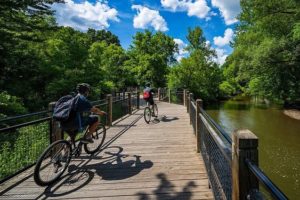Dive into November’s News to Us for updates on federal water infrastructure investments and a proposed Michigan state septic system fund. This month’s articles discuss initiatives from university and high school researchers to collect data on the Huron River to inform flood mitigation efforts. There’s also a new study from the Southeast Michigan Council of Governments outlining area priorities for parks and recreation.

Infrastructure bill would send more than $10 billion to Michigan
The new $1.2 trillion federal Infrastructure Investment and Jobs Act includes numerous line items for water-related improvements. The bill is likely to send $1.3 billion to Michigan for water infrastructure improvements, namely the removal of lead service lines. Nationwide, it dedicates $10 billion to PFAS clean up, $1 billion to the Great Lakes Restoration Initiative, and $3.2 billion to stormwater infrastructure improvements.
Reduce flooding from backed up sewers? There’s an app for that
Researchers at the University of Michigan are helping local governments and water resources professionals, including the Great Lakes Water Authority and the Washtenaw County Water Resources Commissioner’s Office, better manage stormwater systems. Using low-cost sensors, the research team collects water level and flow data on retention ponds, rain gardens, and creeks to improve understanding of stormwater dynamics.
As Michigan lawmakers ponder septic repair funds, Ohio offers a model
With an influx of COVID-19 relief funds, Michigan lawmakers are hoping to set up a septic repair fund similar to a program in Ohio. Michigan is the only state in the nation without a statewide sanitary code, yet home to roughly 1.4 million septic systems, 20 percent of which are likely to be failing. The proposed fund would provide tens of millions of dollars to help homeowners fix leaky septic systems thereby mitigating the pollution of nearby waterways.
What is the new future of Southeast Michigan’s parks, post-COVID?
In its new report, the Southeast Michigan Council of Governments (SEMCOG) identifies priorities and challenges for the region’s parks, trails, and recreation. Following a surge in park visitors during the COVID-19 pandemic, stakeholders are eager to ensure continued use of parks while also promoting equitable access and expanded offerings.
Students get involved to help with Huron River flooding
Students from Howell’s Innovation Academy are collaborating with HRWC board member Dr. Amber Bismack and the group Residents Working Against Huron River Flooding to study the river using an underwater drone. The project engages students in their local watershed and collects information to help the community better understand the river and prevent future flooding.



